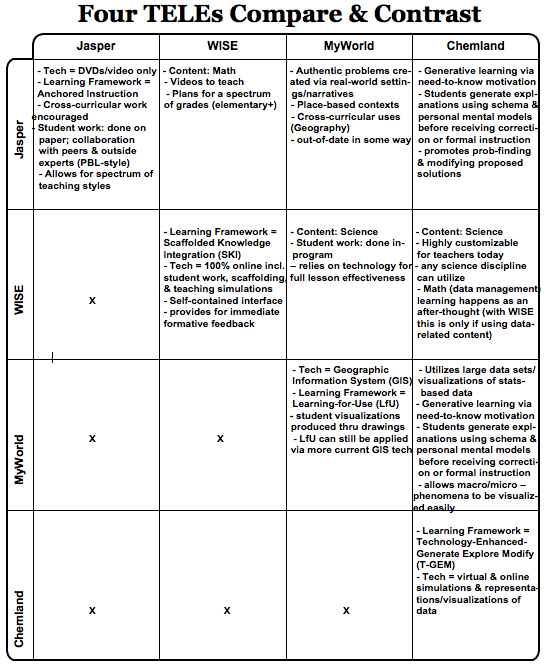The four learning theories we explored in Module B have many similarities among and between themselves. All four theories (Anchored Instruction, Scaffolded Knowledge Integration, Learning-for-Use, and Generate-Evaluate-Modify) are founded in constructivist pedagogy, particularly in the way student knowledge is created and how teachers need to design learning experiences if they really believe this to be true. All four theories are concerned with student motivation, curiosity, and reflection in order for true learning to occur. All believe that an authentic context to some degree or another must be used to anchor student explorations and subsequent evaluations of hypothesis/explanations. All promote the teacher as a facilitator who is not the primary source for disseminating knowledge and who deliberately withholds pertinent information along the way, releasing it only after students have become engaged in the problem, have realized they need the information, or have proven unable to generate the information among themselves. Problem-finding and problem-solving are valued, and confusion or even frustration when confronted with outlier cases or unknown formulas/information is embraced as a fundamental prerequisite for generative learning.
A Graphic Comparison
I created a graphic organizer to sort my thoughts when comparing and contrasting other aspects of these TELEs:

Synthesis
From the exploration of the above learning theories, I’ve learned that technology use for education, whether STEM or other subjects, should be deliberate and purposeful. Teachers should become aware of well-designed technology-enhanced spaces, such as WISE projects and PhET simulations, or design/modify their own TELEs to meet learning needs based on their own foundational pedagogical beliefs. Constructivist theories can be well-served using TELEs when teachers invest time initially to reflect, research, and plan how best to integrate the tenants of constructivism (student-centered, teacher-facilitated, curiosity-driven, and collaboration-based explorations and reflections) using technological tools. Simulations, visualizations and large data-sets are excellent tools for generating curiosity and recursive, adaptive feedback, as well as for promoting social learning through generative discussions, explorations, evaluations and explanations of mental models. Narrative structures and place-based learning also encourage learners to become more motivated to find problems and evaluate their own solutions because real-world, authentic contexts make STEM ideas visible and therefore more relevant. Inquiry-based learning does not always have to mean messy experiments, maker-spaces, or individual research projects; the foundations of inquiry (curiosity, needs-driven knowledge seeking, and communication) can be accomplished through classroom structured lessons rather than only in laboratory contexts. These learning theories and their related TELEs did a great job of articulating in a practical way how teachers desiring a more constructivist pedagogical approach can actually promote and maintain students positions in their Zones of Proximal Development by showing that pre-teaching content before asking them to solve problems using that knowledge is not necessary and perhaps even counter-productive to the process of inquiry needed to reduce the development of “inert knowledge” and promote the development of “generative learning”.
Great reflection and synthesis Jan. I think it is so important that you discuss how teachers need to design and plan student learning engagements carefully and purposefully. One feature I noticed while inquiring into these TELEs is that they are flexible and should be crafted and altered to fit student needs. Occasionally I observe that when teachers plan upcoming units, they begin by discussing what they have done in previous years and frequently will do the ‘same thing’ just because it worked in the past. While I think looking at past experiences is valuable, I wonder if it would be better to start by first uncovering what your students already know about a topic and what their misconceptions are and then plan what to do next so that it is genuinely student-centered around the students who are currently in your class. When it comes to planning what is best practice in your school context?
Cheers,
Sarah
Hi
I like the fact that you mentioned: “disseminating knowledge and who deliberately withholds pertinent information along the way”. I bet this could be difficult for some teachers. I know when my wife buys me a present early – she cannot wait until my birthday or Christmas to open it. On the other hand, I can and this frustrates her 🙂
I wonder when virtual reality or augmented reality will be a commonplace in the classroom. I know apple is playing with this…see the bottom of this page for some science ideas https://www.apple.com/ca/ios/augmented-reality/
Christopher
Hello Sarah and Christopher,
I apologize for my lack of responses and I know you will likely not see this reply. I did not see your replies until today while I was preparing for my eFolio.
@Sarah I would say frankly that there are no best practices related to planning that are generic to my building. Teachers who have taught the grade/subject year over year often use their Year At a Glance from the previous year, recycling it by changing the date. I think this is common. As they go along, they may find the students are unable to handle the previous year’s components and then revise accordingly. If they are like me, their plans will often go out the window simply because I get bored of doing the same things over again or in my position as Library/Tech teacher have discovered a new way of approaching or supporting a particular concept. What about at your school?
@Christopher I agree that it is difficult to withhold pertinent information, I think that this is a new concept for most teachers and definitely not something that is promoted in teachers college or in their observations and practicums. I think it is a valuable concept nonetheless because it reveals that one can pursue constructivist pedagogies for learning without the “chaos” that some teachers associate with it and are uncomfortable with. Alas, I think we have a long time to wait before VR and AR are commonplace in most classrooms.